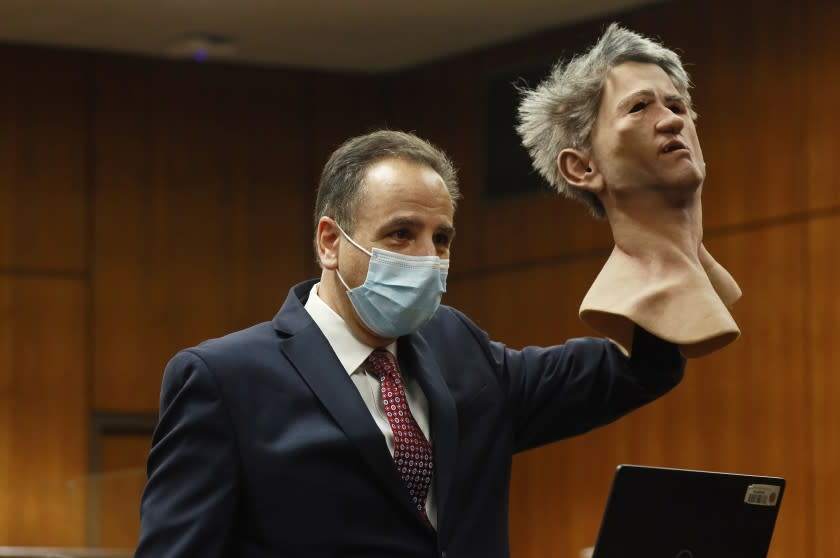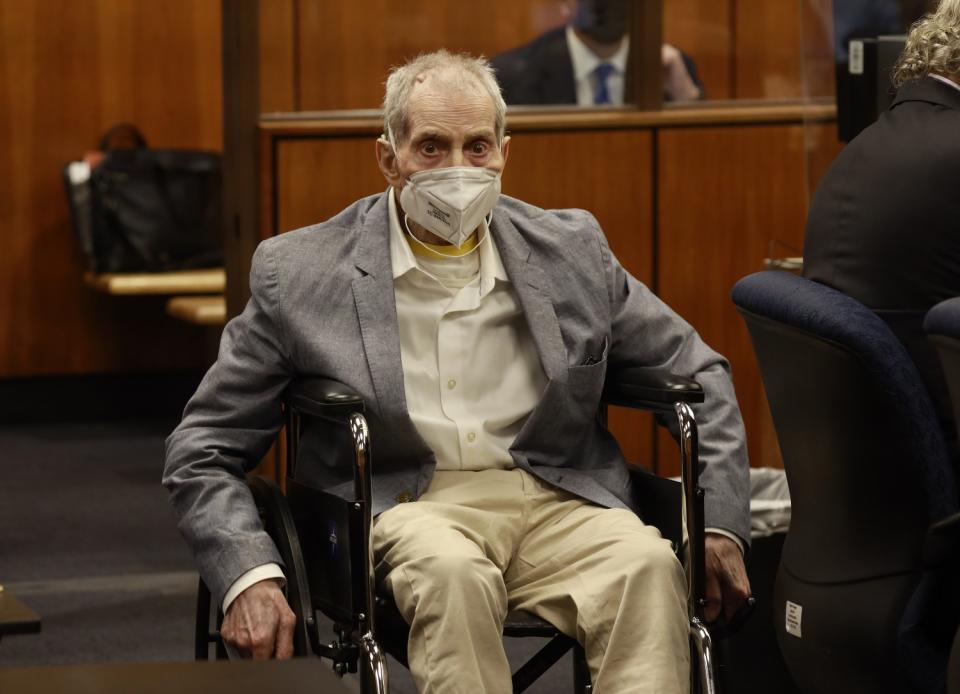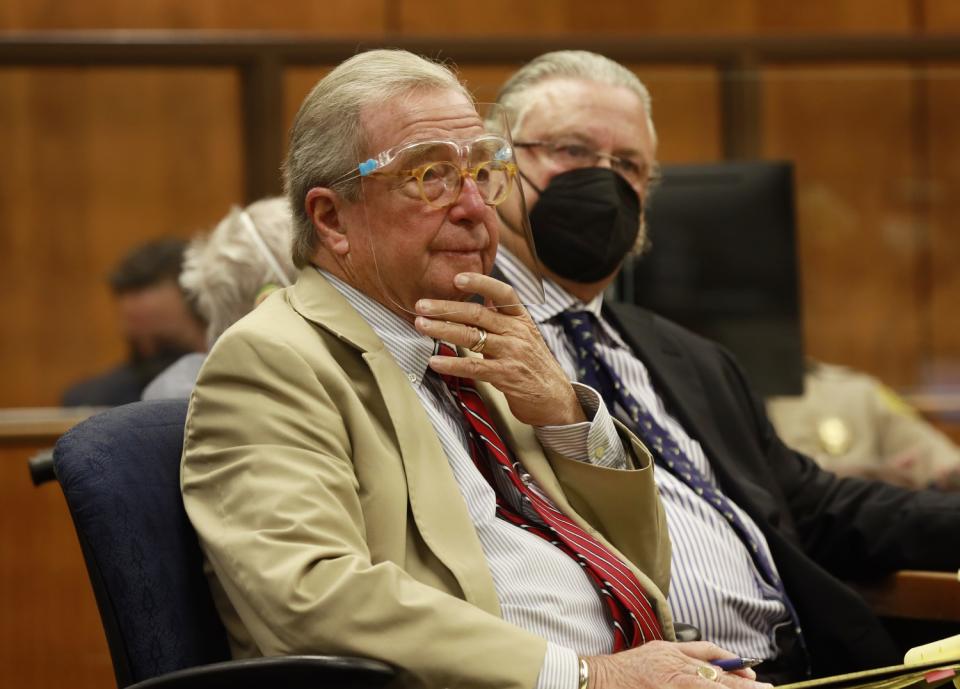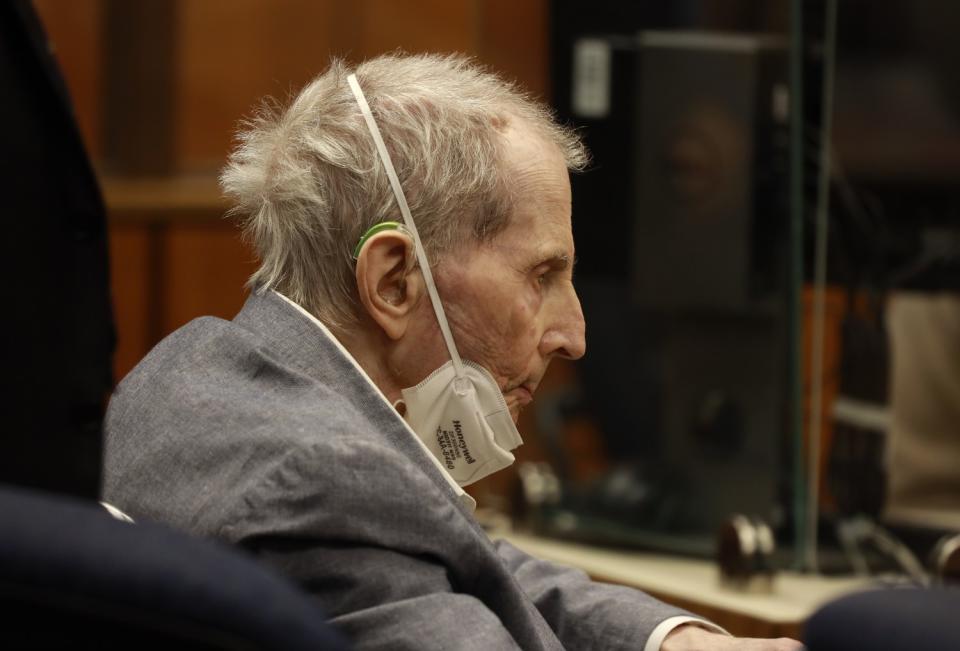'A loud and horrible truth': Prosecutors deliver closing argument in trial of Robert Durst

- Oops!Something went wrong.Please try again later.
Summing up months of testimony, Deputy Dist. Atty. Habib Balian plucked the key fragments of memory from dozens of witnesses, the small details from reams of yellowing documents, that make up the state’s case against Robert Durst.
It is a case that spans four decades, that attempts to prove Durst, the heir to a famed Manhattan real estate empire, committed one murder to cover up an earlier one. It is a labyrinthine account of a curious life defined by power, wealth and alienation.
Balian acknowledged the length of the trial, the breadth of time, places and people it encompasses. Then he faced the jury tasked with deciding Durst’s guilt and said, “At its heart, this case is easy.”
Durst, 78, is charged with murdering Susan Berman in her Benedict Canyon home in 2000. Her death can be explained, Balian told the jury, only by looking back 18 years earlier, when Durst’s wife, Kathie, vanished and was never seen again.
Durst killed Berman, the prosecution’s theory goes, because she knew he had killed his wife and helped him cover it up. Years later, one of Durst's closest friends would ask him about Berman. "It was her or me," Durst said, according to his friend's testimony. "I had no choice."
"Those nine words," Balian told the jury, "sum up the entire case."

Robert and Kathie Durst married in 1973. His family, one of New York City’s wealthiest, controlled a real estate profile that included some of the city’s most iconic buildings. Kathie was from a more humble, working-class family; Durst, many years later, told an HBO documentary crew that he felt he was marrying “beneath me.”
But before long Kathie began to surpass her husband — intellectually, professionally, emotionally, Balian said. She graduated from nursing school and enrolled at Albert Einstein College of Medicine, with dreams of becoming a doctor.
Durst responded by trying to control her, Balian said. In 1976, when Kathie learned she was pregnant, Durst told her she could get either an abortion or a divorce. The abortion, Balian said, was “the inflection point” in their marriage, the moment that Kathie realized her husband wasn’t just controlling the little things in her life.
Before long, Balian told the jury, Durst began to physically abuse his wife. She wore sunglasses to class to hide black eyes. A professor recalled her expression of “pure terror” when she confided in him that her husband had a “homicidal side.” But Kathie wouldn’t leave her husband until she had finalized a divorce, fearing it might jeopardize any financial settlement, Balian said.
On Jan. 31, 1982, Kathie showed up, uninvited, at the Newtown, Conn., home of her close friend, Gilberte Najamy. She was upset, frantic, Najamy’s sister recalled. She had gotten into an argument with Durst at their cottage in South Salem, in New York’s Westchester County.
From Najamy’s home, Kathie called a friend, Peter Schwartz, and asked about a lawsuit he had filed against her husband. Schwartz had accused Durst of attacking him as he sat with Kathie, breaking his orbital bone with a kick to the face. Schwartz told Kathie the suit had been dismissed. She grew upset, Schwartz recalled, and she insisted that he keep pressing the lawsuit.
Then Kathie got a call from Durst. She told Najamy she had to leave.
When she returned to the South Salem home, they got into a “pushing and shoving argument," Durst told the documentary crew. He said she accused him of “bribing the lawyers,” a reference, Balian said, to Schwartz’s thwarted lawsuit.
Kathie was supposed to show up the next day for a rotation at Bronx Memorial Hospital. She didn’t. No one has seen her since.
“Her continued absence for the last 39 years speaks a loud and horrible truth,” Balian said.

Durst’s housekeeper testified that after his wife vanished, he told her to throw out Kathie’s clothes and medical books. Najamy’s sister, digging through the garbage cans outside the South Salem home, found Kathie’s textbooks and other belongings. Also found in a trash can was a piece of paper scribbled with the words “town dump bridge dig boat other shovel or? check car trunk / rent.”
Balian called this “a list, a plan” to get rid of Kathie’s body. Asked about it at trial, Durst said that “dig” was short for “digital,” in reference to a computer system, and that “boat” and “town dump” referred to a plan to hire some teenagers to haul his sailboat to the dump. Balian called this “one of the most absurd lies told in this entire trial.”
Two days after his wife disappeared, Durst made several collect calls from the New Jersey towns of Barnegat and Beach Haven, according to phone records admitted at trial. Balian said these towns were near the Pine Barrens, a remote, wooded area with soft, sandy soil — implying this was where Durst buried his wife's remains.
One day earlier, between 9 a.m. and 11 a.m. on Feb. 1, 1982, the dean of Albert Einstein College of Medicine got a call from a woman who identified herself as Kathie Durst. She said she was ill and wouldn’t be coming to class that day.
Prosecutors believe Berman made that phone call.
Berman, the daughter of a gangster who took over the Flamingo hotel in Las Vegas from Benjamin "Bugsy" Siegel, was taught to value loyalty above all else, friends testified. Seeing her mother guard her father’s secrets, Berman “came to understand that was a big part of love,” said her friend Lynda Obst.
Berman revered Durst, whom she met at UCLA in the 1960s. “She loved him, so she would have protected him at all costs,” Balian told the jury.
After Durst's wife vanished, he and Berman “embarked on a campaign to obscure the truth,” Balian said, to send the police down the wrong path, chasing down the wrong leads.
Berman acted as Durst’s spokeswoman, disparaging his missing wife to newspaper reporters and detectives as a cocaine addict, a poor student and an unstable spouse. Like Durst, she wasn’t interested in finding Kathie, who she knew was dead, Balian argued; she wanted police and the public to think Kathie was “a junkie who had walked away from her life.”
But over the years, she confided in friends that she had done a terrible thing. One recalled Berman saying that she had done “something for Bobby” and that if anything should happen to her, “Bobby did it.”
“She spoke to you through her friends,” Balian told the jury. “‘I helped him. I made the call.’”

In 1999, a New York state police detective revived the investigation into Kathie’s disappearance. Before long, it made the front page of the New York Daily News.
One might expect a husband to feel a sense of relief, of hope renewed, Balian said, to learn the authorities had resumed looking for a long-missing spouse. Durst’s reaction, as he testified during an earlier trial in Galveston, Texas: “It made me sick to my stomach.”
Berman, meanwhile, was leveraging what she knew of Kathie’s disappearance for money, Balian said. She had been raised in a wealthy family and enjoyed some success as a writer. But by the time New York authorities had revived their investigation, Berman was struggling, sliding into debt, worrying about her rent and unable to pay her hairdresser, witnesses testified.
Durst had given Berman money over the years “to keep her close, to keep her quiet,” Balian said. But with her finances looking increasingly bleak, Berman grew frustrated, even desperate.
“What would a desperate Susan Berman do?” Balian asked. “That’s the real question.”
Berman told Durst that Los Angeles police had contacted her, wanting to talk about Kathie, Durst had told the documentary crew.
“That was the moment Susan Berman sealed her fate,” Balian told the jury. Durst, he said, traveled to Los Angeles with the intention of executing his best friend.
Durst acknowledged that he was in Los Angeles at the time of Berman’s death, but he testified that the two had planned a “staycation” for the Christmas holiday, to visit Santa Catalina Island, Disneyland, Century City. But when he got to Berman’s Benedict Canyon home, letting himself in with a loaned key, he said, he found her lying on the floor of a bedroom, shot in the back of the head.
Durst claimed to have tried to dial 911 from her landline but found it wasn’t working. He said he drove to a pay phone, then hesitated, not wanting the police to identify him through his voice. He testified that he decided instead to mail a note to the Beverly Hills police, alerting them to a “cadaver” in Berman’s home.
Durst spent years denying that he wrote what has come to be called the “cadaver note.” But in 2019, he acknowledged through a stipulation that he had in fact written it. “It’s a very difficult thing to believe,” he acknowledged on the witness stand. “I mean, I have difficulty believing it myself, that I would write the letter and not kill Susan Berman.”
Balian called this version of events “patently absurd.” The more logical explanation, he told the jury, was that Durst showed up at Berman’s home; that Berman, a notoriously paranoid person, let him in; that he waited until she turned her back to him and fired one round into the back of her head from less than an inch away.
“No matter what she did,” Balian said, “no one deserves to be executed.”
Durst's attorney Dick DeGuerin was expected to begin his closing argument Thursday afternoon.
This story originally appeared in Los Angeles Times.

